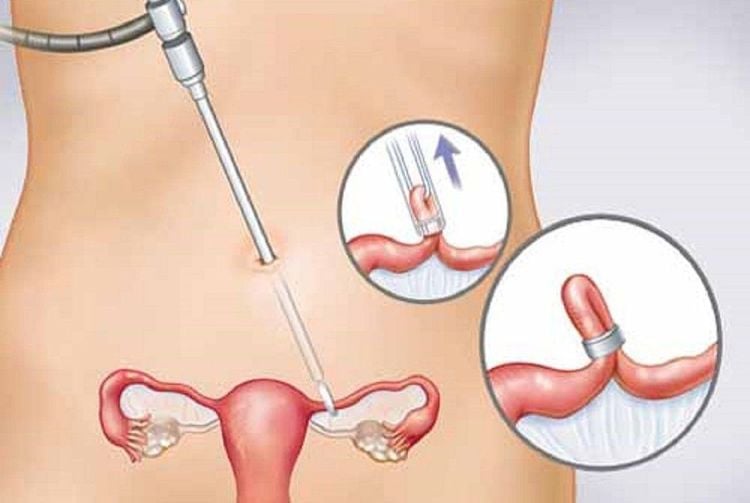1. Common methods of birth control
Some common birth control methods such as using condoms, using oral contraceptives, using contraceptive devices... each method of contraception above has its own advantages and disadvantages and is highly effective when you are pregnant. Use according to the instructions. However, there is always a chance that you will experience your own failure rate for each method. Choosing the right birth control method depends on the following factors:Your own health condition. Safety and effectiveness of contraceptives of choice. Are you comfortable and satisfied using that contraceptive? Are you planning to become pregnant in the near future? Your frequency of sexual activity and number of sexual partners.
2. What is a permanent method of birth control?
A permanent method of birth control is a method of female sterilization or male sterilization. Taking this method also means that you definitely don't need to have children anymore.In female sterilization, the fallopian tubes are blocked to prevent sperm and egg from meeting. This method is considered by experts to be safe, permanent birth control, suitable for women aged 30 years and older.
In male sterilization procedures, vasectomy is used effectively by doctors and accounts for 20% of all male sterilization cases. This is a relatively simple technique, even without the use of a knife.

3. Permanent contraception by sterilization method in women
3.1. In what cases is permanent contraception by sterilization in women performed? The decision to have sterilization is up to you, but medically, sterilization in women is divided into the following groups:Women with medical problems : Female patients with heart disease severe, if pregnant, during pregnancy, the disease will worsen or decompensate. In these patients, sterilization is the best approach. In addition, patients with diseases such as severe hypertension, chronic lung disease, vascular - kidney disease, genital cancer, breast cancer, or blood diseases, genetic diseases.... Doctors prescribe sterilization to prevent pregnancy forever. Patients who perform obstetrics and gynecological surgery: Female patients with a history of multiple cesarean sections, uterine fibroids, genital prolapse... are also advised to sterilize by doctors to avoid future consequences. . From a social perspective: Permanent contraception by sterilization should be done in families with many children whose economic conditions are not enough, increasing the burden on family life and affecting health. own. In terms of population: Permanent contraception by sterilization method is applied compulsory in developing countries with too high population, affecting the development of society. 3.2. When is the best time to perform female sterilization? In non-pregnant women, sterilization is best performed after the menstrual period has ended, which will help rule out the procedure on a pregnant woman.
In pregnant women, sterilization is best done during cesarean section or postpartum period. Doctors perform the procedure in the postpartum period preferably between 24 - 36 hours after giving birth to reduce the risk of bleeding and the mother can rest after delivery. In case, the woman's water breaks prematurely, has a fever during labor and is at risk of infection, the doctor should temporarily stop the procedure, possibly moving to the 8th week postpartum.
Female sterilization procedures are performed by doctors according to the following methods:
Laparoscopy Laparoscopy hysteroscopy Minimal laparotomy 3.3. Laparoscopic female sterilization laparoscopic female sterilization is performed by experienced obstetricians and gynecologists.
Before performing the technique, the doctor needs to prepare a number of issues as follows:
The doctor needs to conduct a full and specialized examination of the patient to evaluate the combined pathology. The doctor explains to the patient the purpose, risks, and complications when performing the procedure and instructs the patient to sign the surgical commitment. The patient was carefully prepared, cleaned the abdomen and vulva, urinary catheterization and disinfected the abdominal wall of the surgical area. The doctor checks to ensure that the patient's medical record meets the requirements as prescribed by the Ministry of Health. The laparoscopic female sterilization procedure is performed as follows:
The doctor chooses the point below the navel as the point of CO2 injection. In case the patient has had surgery around the navel, the doctor chooses the needle point in the right lower quadrant or conducts open laparoscopic surgery. After injecting the needle, the doctor proceeds to pump CO2 to the desired pressure (about 15 mmHg). The doctor places a 10mm or 5mm trocar at the umbilicus, exposing the entire pelvis to observe the uterus and fallopian tubes. The doctor performs sterilization by burning the fallopian tube with a double-pole knife at the position close to the two tubes, using a single-pole knife to cut the fallopian tube in half at the burning position. Next, the doctor uses a bipolar knife to re-burn the two tips of the tubal cutting process. After performing the procedure, the doctor performs abdominal washing for the patient, makes a final check, withdraws the trocar and stitches the skin to complete the technique. Laparoscopic female sterilization surgery may experience some complications such as damage to the digestive system, blood vessels, bleeding during surgery...

3. Permanent contraception by male sterilization method
Male sterilization method is also known as vasectomy and is considered a relatively simple technique. However, this technique is also contraindicated in some of the following cases:Patients with coagulation disorders, body weakness. The patient has inguinal hernia, varicose veins, chronic inflammation and vestiges in the spermatic cord. Before performing the procedure, the doctor needs to prepare the following factors:
The doctor needs to explain to the patient about the preoperative examination process, the area to be operated on, the benefits and disadvantages after the procedure. show tricks. The patient is done basic tests such as blood clotting test... After the procedure is done successfully, the patient is rested for about 30 minutes to 1 hour. The doctor needs to advise the patient on the steps of wound care after surgery, the correct use of drugs as prescribed by the doctor, the right diet and the avoidance of foods that affect the wound.
A vasectomy does not change the function of the testicles and the male sex hormone testosterone is still produced normally. According to recommendations from doctors, male sterilization procedure is not effective immediately after the procedure, but the patient needs to use emergency contraception during the first 20 times of sexual intercourse or about 3 months after. surgery.
Thus, permanent birth control can be performed in both men and women safely and with high efficiency.
Vinmec International General Hospital is one of the hospitals that not only ensures professional quality with a team of leading medical doctors, modern equipment and technology, but also stands out for its examination and consultation services. comprehensive and professional medical consultation and treatment; civilized, polite, safe and sterile medical examination and treatment space.
Để đặt lịch khám tại viện, Quý khách vui lòng bấm số HOTLINE hoặc đặt lịch trực tiếp TẠI ĐÂY. Tải và đặt lịch khám tự động trên ứng dụng MyVinmec để quản lý, theo dõi lịch và đặt hẹn mọi lúc mọi nơi ngay trên ứng dụng.









